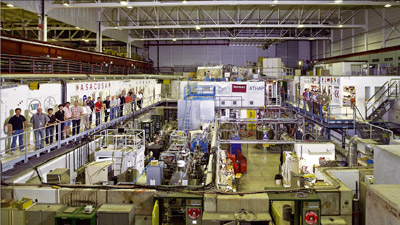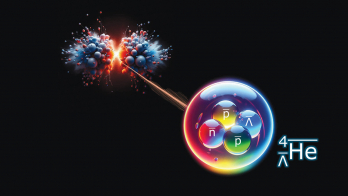
Research at CERN’s Antiproton Decelerator (AD) has made important breakthroughs in experimental techniques for studying antihydrogen in the laboratory. On 17 November, in a paper published in Nature, the ALPHA collaboration announced that it had successfully trapped atoms of antihydrogen for the first time. Then, on 6 December, the ASACUSA collaboration published results in Physical Review Letters on a technique that should allow the production of a beam of antihydrogen. Recognition of these achievements soon followed in the scientific media, with the award of Physics World‘s “2010 Breakthrough of the Year” on 20 December.
Both ALPHA and ASACUSA aim to measure precisely the spectrum of antihydrogen and compare it with that of hydrogen. Any small difference would cast light on the imbalance between matter and antimatter in the universe today. The first nine atoms of antihydrogen were produced at CERN in 1995. Then, in 2002, the ATHENA and ATRAP experiments at the AD showed that it was possible to produce large quantities of cold (i.e. very low velocity) antihydrogen, thus opening up the possibility of conducting detailed studies. However, the challenge remained of producing the antihydrogen in such a way that its spectrum could be analysed.
The strategy being pursued in the ALPHA experiment, which evolved from ATHENA, is to make cold antihydrogen and then hold the neutral antiatoms in a superconducting magnetic trap similar to those used for high-precision atomic spectroscopy. The ultimate aim is to measure 1s–2s transitions for comparison with the latest results in hydrogen. The ALPHA trap consists of an octupole and two solenoidal “mirrors”, which together create a magnetic field that confines the antiatoms by interacting with their magnetic moments. Silicon detectors surrounding the trap record the annihilations of any trapped antihydrogen once it is released. In the studies reported in November, the collaboration observed 38 annihilations (Andreson et al. 2010).
The ASACUSA experiment is following a different approach aimed at studying hyperfine transitions in antihydrogen, which involve much smaller energy differences and hence microwave rather than laser spectroscopy. The technique does not require the antiatoms to be trapped, so the collaboration is taking steps towards extracting a beam of antihydrogen in a field-free region for high-resolution spectroscopy. The December paper reports success in producing cold antihydrogen in a so-called “cusp” trap, an essential precursor to making a beam. This trap consists of a superconducting anti-Helmholtz coil and a stack of multiple ring electrodes (Enomoto et al. 2010). The next step will involve extracting a spin-polarized antihydrogen beam along the axis of the trap.
Further reading
G B Andreson et al. 2010 Nature 468 673.
Y Enomoto et al. 2010 Phys. Rev. Lett. 105 243401.







